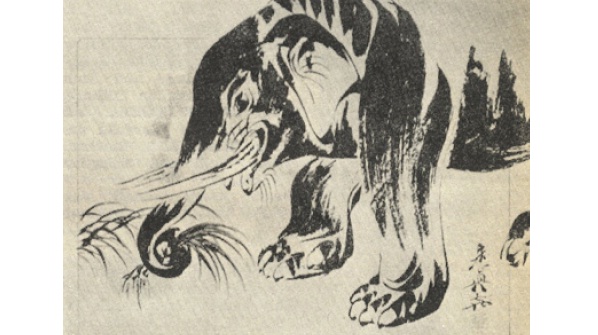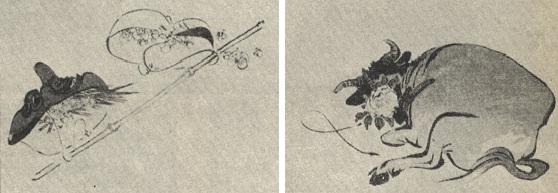SHIBATA ZESHIN AND HAWAII
by Fred Harris
Hawaii offers an abundance of pleasures. One of the best, yet perhaps the least known, is the Honolulu Academy of Arts. It is housed in a tropical looking building out of a Somerset Maugham novel containing enchanting courtyards and galleries filled with some of the world’s great treasures. The Academy is downtown, a short and inexpensive taxi ride from most hotels.
In an environment where money counts, this pleasure house is unique, because it’s free—although there is a glass box full of dollars where the visitor, so overjoyed with what he has seen, usually makes a contribution so this wonderful institution can continue to prosper.
The Academy is especially strong in its holding of Asian art, and within this large grouping is a well designed, environmentally controlled room devoted exclusively to the works of Japan’s greatest artist in the medium of lacquer, Shibata Zeshin. The cases are full of trays, boxes, dishes, cups and numerous netsuke, inro and tobacco pouches made by this wonderful craftsman. Also on view are his sketches, paintings and drawings in ink and/or lacquer on paper and silk and a superb representation of his woodblock prints.
This vast and unusual collection devoted to the works of one artist was collected by Mr. & Mrs. James O’Brien for a period of 23 years starting in 1955 and given to the Academy in its 50th year in 1977. The collection attests to the fine taste and sophistication of this American couple. Their names will be remembered through the ages for their efforts in bringing together this superb treasure and offering it to the public at large for their enjoyment.
Zeshin lived through the most exciting period in Japanese art history. He was born in 1807 and died in 1891. He witnessed the slow changes from the official Kano traditions to the penetrating realism of the Maruyama-Shijo School of painting. The Ukiyoe print world was on the highest plane of accomplishment, and the landscapes of Hokusai and Hiroshige were taking over the print market place. The black ships arrived and with them a whole new phase of art, commonly referred to today as Yokohama pictures.
Yet with this wide universal explosion on the perimeter of Zeshin’s world he became the center of the vortex, turning deeply into the opposite world of the minute, focusing on the life of the smallest creatures, insects, flowers, fruit, fish and the small animals which inhabit the universe of the Japanese garden. The exception would be his frequent entry into the world of Japanese folklore and mythology.
Zeshin received his training in the art of lacquerware as well as painting. He studied from Watanabe Nangaku, one of Maruyama Okyo’s 10 best pupils. Nangaku had an open mind and encouraged young Zeshin to investigate the truth in nature by studying philosophy and poetry. His enthusiasm for Haiku eventually led him to follow Basho’s footsteps and take a pilgrimage to the deep north. This trip took him through Nikko, Matsushima and eventually as far as Akita.
Forever a student, he used this opportunity to copy famous paintings along the way, as well as sketch the scenery he passed. We must remember that in the periods prior to photography and printing the only way an artist could study and keep a record of the art he saw was to make copies. This occurred in Europe as well as Asia.
In the 1860s the Shogun gave up the seat of government to the Emperor and Japan started its active participation in international affairs. There was a Japanese pavillion in the Worlds Fair of 1873 in Vienna. The government commissioned Zeshin to create a large framed picture in lacquer to decorate the exhibition hall. Zeshin’s scene of Ml, Fuji and the life around the mountain base is considered one of his crowning achievements.
The impression his work made paved the way for entries into international expositions in Philadelphia in 1876, Nagoya in 1878 and Kyoto in 1879. He developed a technique of being able to paint in lacquer, allowing it to be rolled up, and resist cracking. His fame for this type of painting became so great during the Meiji period that his name became synonymous with lacquer art at that time.
Zeshin style is unique in its clarity. The lines are unhesitating, clear and very descriptive, Zeshin could easily have adapted himself to any school of illustration worldwide. As the viewer concentrates on each picture there is constant enjoyment in discovering second readings of small details which his line describes. Because of his involvement with the craft of lacquer and its uses for writing-boxes, inro, netsuke and tobacco pouches; Zeshin was accustomed to working small.
The collection in Hawaii, because of the generally small size of its objects, becomes quite intimate. The viewer has to look close, and this near proximity draws you deeper into the piece being studied. Many of the pieces are only a few inches square. It becomes another world; the world of the miniature where you grasp the entire scope without moving your eyes.
Some of Zeshin’s more attractive pieces are his interpretations of animals in human situations. This subject matter has a long history in Japan, but nowhere is it more delightful than in Zeshin’s work. In some ways this is attributable to the richness of the lacquer medium. Even in reproduction the lacquer contains a fullness and body not realized in other mediums. Black becomes very dense, as do the earth colors Zeshin ordinally used.
I’m sure my friend Charlie Mitchell would not mind me quoting a paragraph from his very comprehensive book “The Illustrated Books of The Nanga, Maruyama, Shijo and Other Related Schools of Japan” which describes Zeshin’s personality better than anywhere else in print.
“Zeshin was showered with invitations from some of the most powerful families in Edobut preferred to stay home and drink sake with a few close friends or by himself. Although generous in many ways, he was always a sternly moral person. When he attended public entertainment events, such as sumo, he always sat upright and never laughed or applauded. He was however warm-hearted and generous toward his pupils and often look them along on picnics and outings, paying their way if necessary.
He was especially interested in sumo and always paid more attention to the losers than the winners. When queried on that point, he replied it was easy to depict the spirit of the winner but difficult to convey the emotions of a defeated man and he felt the depiction of difficult emotions was the real business of art.
I can not recommend anything more wonderful than a side trip to the Honolulu Academy of Arts the next time you are in Hawaii. See this remarkable Zeshin Collection.










